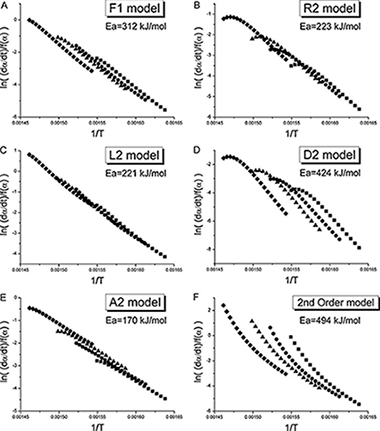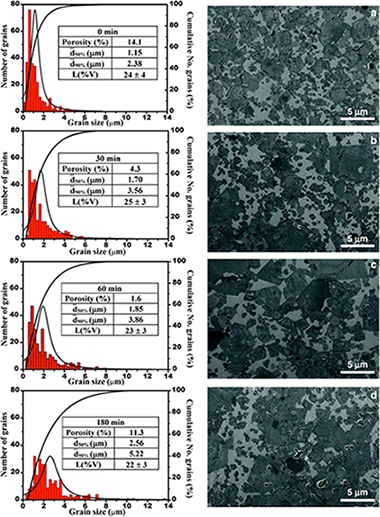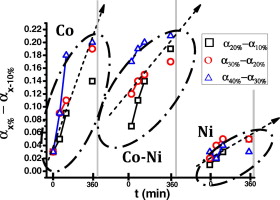Artículos SCI
2013
2013
Reactividad de Sólidos
Limitations of model-fitting methods for kinetic analysis: Polystyrene thermal degradation
Sanchez-Jimenez, PE; Perez-Maqueda, LA; Perejon, A; Criado, JMResources, Conservation and Recycling, 74 (2013) 75-81
Show abstract ▽

In this paper, some clarifications regarding the use of model-fitting methods of kinetic analysis are provided in response to the lack of plot linearity and dispersion in the activation energy values for the thermal degradation of polystyrene found in the literature and some results proposing an nth order model as the most suitable one. In the present work, two model-fitting methods based on the differential and integral forms of the general kinetic equation are evaluated using both simulated and experimental data, showing that the differential method is recommended due to its higher discrimination power. Moreover, the intrinsic limitations of model-fitting methods are highlighted: the use of a limited set of kinetic models to fit experimental data and the ideal nature of such models. Finally, it is concluded that a chain scission model is more appropriate than first order.
Mayo, 2013 | DOI: 10.1016/j.resconrec.2013.02.014
Reactividad de Sólidos
Effect of sintering time on the microstructure and mechanical properties of (Ti,Ta)(C,N)-based cermets
Chicardi, E; Torres, Y; Cordoba, JM; Sayagues, MJ; Rodriguez, JA; Gotor, FJInternational Journal of Refractory Metals & Hard Materials, 38 (2013) 73-80
Show abstract ▽

Complete solid-solution cermets based on titanium–tantalum carbonitride using a starting nominal composition with 80 wt.% of (Ti0.8Ta0.2)(C0.5N0.5) and 20 wt.% of Co were performed by pressure-less sintering at 1550 °C for different times (from 0 to 180 min) in an inert atmosphere. Chemical and phase analyses were conducted using X-ray diffraction (XRD), elemental analysis and energy dispersive X-ray spectrometry (EDX). The binder mean free path and the contiguity of the carbonitride particles were used to rationalise the microstructural effects of the mechanical behaviour. Mechanical characterisation included determining the Vickers hardness, the fracture toughness (conventional indentation microfractures, IM), the dynamic Young's modulus (ultrasonic technique), the biaxial strength (ball on three ball) and a detailed fractographic examination. Finally, the experimental findings were combined with a theoretical fracture mechanics analysis to estimate the critical processing flaw sizes. Binder-less carbonitride clusters, pores and coarse carbonitride grains were the main defects observed and were responsible for the fractures.
Mayo, 2013 | DOI: 10.1016/j.ijrmhm.2013.01.001
Química de Superficies y Catálisis
Steam reforming of methanol over supported Ni and Ni–Sn nanoparticles
Bobadilla, LF; Palma, S; Ivanova, S; Dominguez, MI; Romero-Sarria, F; Centeno, MA; Odriozola, JAInternational Journal of Hydrogen Energy, 38 (2013) 6646-6656
Show abstract ▽

The influence of the synthesis method and Sn addition on Ni/CeO2–MgO–Al2O3 catalyst is correlated to its catalytic behavior in the reaction of methanol steam reforming. The catalysts prepared by impregnation method are compared to samples obtained by deposition of previously obtained nanoparticles by the polyol method. X-ray diffraction (XRD), specific surface area measurements and H2-temperature programmed reduction (TPR) were used to characterize the catalysts. The differences of the structure, phase transformation and reduction behavior are discussed and related to the catalytic performance of the samples as well as the nature of the carbonaceous deposits formed during the reaction.
Mayo, 2013 | DOI: 10.1016/j.ijhydene.2013.03.143
Reactividad de Sólidos
Liquid-phase sintering of Ti(C,N)-based cermets. The effects of binder nature and content on the solubility and wettability of hard ceramic phases
Cordoba, JM; Chicardi, E; Gotor, FJJournal of Alloys and Compounds, 559 (2013) 34-38
Show abstract ▽

Different commercial TiC–TiN/Co/Ni mixtures were used as raw materials for Ti(C,N) cermets, and the effects of the sintering parameters (binder content, binder nature, sintering time and additives) on the final hard ceramic phase were studied at the sintering temperature of 1400 °C. When Co is used as the binder medium, it is possible to completely convert the starting commercial TiC–TiN mixture into TiCxN1−x. When Ni is used, which exhibits lower solubilising capacity than Co, the total conversion can never be reached and the metallurgical reactions between TiC and TiN during the liquid-phase sintering are more dependent on the sintering time than on the binder content. However, the use of Co–Ni mixtures, showing a synergic effect between the wettability capacity of Ni and the solubilising capacity of Co, enhances the metallurgical reactions at short sintering times.
Mayo, 2013 | DOI: 10.1016/j.jallcom.2013.01.046
Nanotecnología en Superficies y Plasma
Differences in n-type doping efficiency between Al- and Ga-ZnO films
Gabas, M; Landa-Canovas, A; Costa-Kramer, JL; Agullo-Rueda, F; Gonzalez-Elipe, AR; Diaz-Carrasco, P; Hernandez-Moro, J; Lorite, I; Herrero, P; Castillero, P; Barranco, A; Ramos-Barrado, JRJournal of Applied Physics, 113 (2013) 163709 (9 pages)
Show abstract ▽
A careful and wide comparison between Al and Ga as substitutional dopants in the ZnO wurtzite structure is presented. Both cations behave as n-type dopants and their inclusion improves the optical and electrical properties of the ZnO matrix, making it more transparent in the visible range and rising up its electrical conductivity. However, the same dopant/Zn ratio leads to a very different doping efficiency when comparing Al and Ga, being the Ga cation a more effective dopant of the ZnO film. The measured differences between Al- and Ga-doped films are explained with the hypothesis that different quantities of these dopant cations are able to enter substitutionally in the ZnO matrix. Ga cations seem to behave as perfect substitutional dopants, while Al cation might occupy either substitutional or interstitial sites. Moreover, the subsequent charge balance after doping appear to be related with the formation of different intrinsic defects that depends on the dopant cation. The knowledge of the doped-ZnO films microstructure is a crucial step to optimize the deposition of transparent conducting electrodes for solar cells, displays, and other photoelectronic devices.
Abril, 2013 | DOI: 10.1063/1.4803063
- ‹ anterior
- 305 of 422
- siguiente ›














